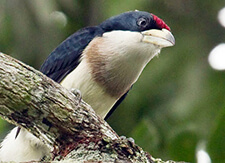
White-mantled Barbet map, NatureServe
Barbets are related to toucans and woodpeckers. They all have "zygodactyl" feet, with two toes facing forward and two backward—an arrangement that helps tree-dwelling birds grasp branches. Barbets play a key role in tropical forests by consuming and dispersing seeds of fruit trees.
Found only in Colombia, the White-mantled Barbet's population is declining as a result of deforestation. It finds refuge in the Cerulean Warbler Conservation Corridor established by Fundación ProAves and ABC, a site that also provides winter habitat for Rose-breasted Grosbeak and other migrants.
Sign up for ABC's eNews to learn how you can help protect birds

White-mantled Barbet by Dusan Brinkhuizen
White-mantled Barbets nest in tree cavities dug by breeding pairs. Their distinctive voice is a deep croak, repeated frequently for long periods.
Erin Lebbin, ABC's Assistant Director of Development, had the pleasure of seeing a pair of these charismatic birds at the El Paujil Reserve, also established by ProAves with support from ABC. She recalls: "We hiked uphill along a wet and muddy trail for one or two hours before arriving at the barbet's habitat. Once we found the birds, I was impressed with their loud and chattery song."
The White-mantled Barbet benefits from ABC's efforts to "bring back the birds." Conserving geographically linked habitats in places both north and south benefits migrants such as Cerulean Warbler and year-round residents like this barbet and the Gorgeted Wood-Quail.
Donate to support ABC's conservation mission!



















































